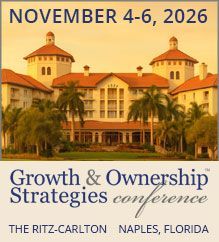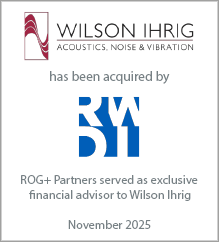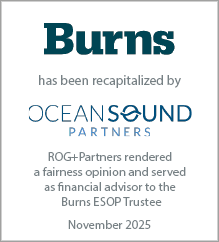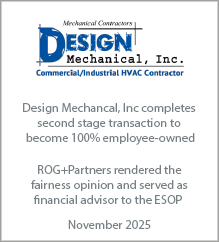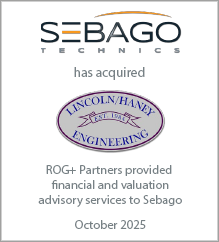Michael S. O'Brien is a principal in the Washington, DC office of Rusk O'Brien Gido + Partners. He specializes in corporate financial advisory services including business valuation, fairness and solvency opinions, mergers and acquisitions, internal ownership transition consulting, ESOPs, and strategic planning. Michael has consulted hundreds of architecture, engineering, environmental and construction companies across the U.S. and abroad.
Why do some A/E firms trade at higher valuation multiples?
May 14, 2025
As I reflect on my 36 years in the advisory industry, I find it valuable to share insights on what I prioritize when evaluating A/E firms and understanding the drivers of their value. Many appraisers heavily rely on experience and key metrics to determine value, but have you ever wondered why some firms command higher valuation multiples than others within the same sector?
Key Variables Influencing Valuation
Among the key variables influencing valuation multiples are earnings capacity, growth potential, and risk. Risk measures the company's ability to maintain operating performance and sustainable growth. Firms that focus solely on financial results may achieve the desired results in the short term. However, high valuation multiples are tied to achieving long-term objectives. It is essential to emphasize the attributes that foster a sustainable business environment.
Strong Leadership
In an architecture and engineering (A/E) firm, you are essentially investing in a group of individuals' ability to lead rather than merely manage. Strong leaders possess a blend of vision, emotional intelligence, effective communication, integrity, decisiveness, inspiration, collaboration, and a results-driven mindset.
To achieve the results of a strong leadership-led organization, companies need to ensure that they are creating an environment for developing leaders, not managers. Far too many firms become bogged down in trying to make the perfect decision, so they never take decisive action.
This is where many companies falter in realizing their valuation potential.
Sophisticated Financial Capabilities
Firms that prepare financial statements solely on a cash basis raise a red flag. To me, it indicates a lack of understanding of accrual-based accounting, which more accurately reflects the true economic performance of project management. While cash-based accounting has its place, it must work in tandem with accrual-based measures.
Companies with inconsistent or inadequate financial reporting—often due to poor project controls such as timesheets and invoicing—are more likely to experience volatile earnings. This lack of accountability in financial reporting can hinder project managers from making real-time adjustments to mitigate project profitability risks.
Implementing advanced key performance indicators (KPIs) allows project managers, business developers, and executives to make informed decisions and respond effectively to changing conditions. However, those KPIs are only as good as the current information available. Waiting for monthly results for performance metrics is too late.
Strong Capital Investments
Firms that consistently make substantial capital investments are laying the groundwork for future earnings streams. You may think that capital investment in the A/E industry, for the most part, is very low. I would disagree. Employees in the professional services industry are assets, and continuous investment in these assets is required to enhance the value they deliver to your clients.
Companies that engage with their employees regularly and thoughtfully often enjoy increased productivity, creativity, and employee retention. Organizations that prioritize employee satisfaction typically see these benefits reflected in their bottom line. Given that professional services firms' key assets are their employees, investing in their development is crucial for ensuring low turnover, high satisfaction, and cultivating an environment that fosters leadership development, which is essential for financial stability.
Simplicity of Business Model
When I first engage with a company, I examine its website to gain insight into its business. Too often, I find either minimal information or overly complex designs that obscure the company's core value proposition.
A straightforward business model is vital. If a firm’s messaging focuses solely on engineering, architecture, or environmental services, it misses the point. Instead, firms should articulate who they are, what they do, how they do it, and why it matters. This clarity communicates how they differentiate themselves from competitors and underscores the value they provide to clients. Engineering may be a commodity, but how firms assist their clients is not.
Focus on Results
Companies with clear, measurable goals are more likely to hold all employees, from the CEO down, accountable. A results-oriented leadership team articulates a clear vision and empowers employees by delegating responsibilities, fostering a sense of ownership, and accountability. For instance, to achieve revenue goals, teams must establish sales targets that translate into actual revenue. Meeting these sales goals requires setting proposal delivery targets.
Using actionable steps with measurable results enables continuous feedback on progress, allowing for ongoing improvement. Employees need to know how they are performing and receive regular feedback. KPIs serve as a tangible tool that provides employees with continuous feedback. These types of tools enable them to self-motivate and develop the skills necessary to become future leaders.
Conclusion
In summary, the key factors that drive higher valuation multiples for companies are:
- A strong leadership team that can meet the challenges of growing and sustaining a stable earnings capacity.
- Sophisticated financial capabilities that go beyond cash-based accounting and implement advanced KPIs to enable real-time decision-making.
- Consistent capital investments in the company's key asset - its employees. Investing in employee development, satisfaction, and retention is crucial for long-term success.
- A simple, easy-to-understand business model that clearly communicates the company's value proposition and differentiates it from competitors.
- A results-oriented culture with clear, measurable goals that hold all employees accountable, enabling continuous feedback and improvement.
Companies that excel in these areas are more likely to command higher valuation multiples, as they demonstrate the ability to generate sustainable growth and profitability over the long term. By prioritizing these factors, companies can position themselves for greater market success and attract investors willing to pay a premium for their shares.


